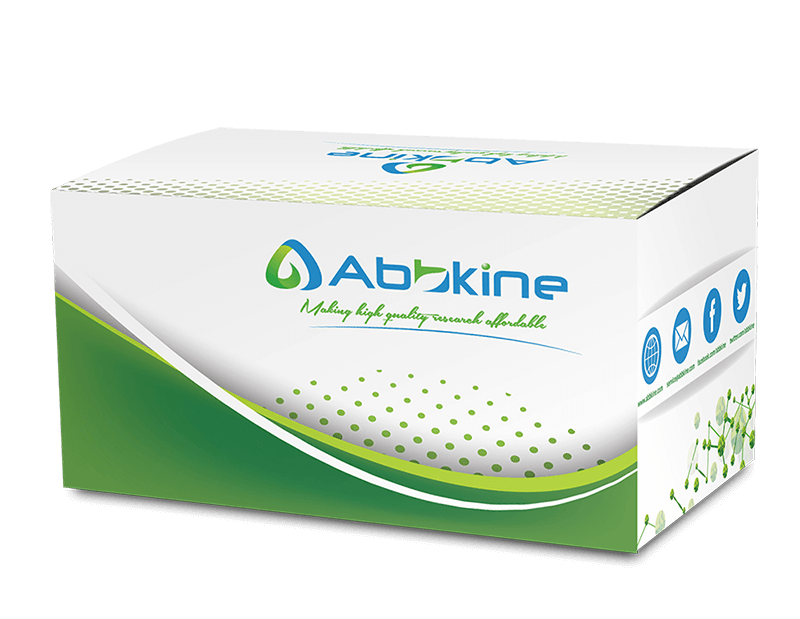

分享产品
His标签兔多克隆抗体
Anti-His Tag Rabbit Polyclonal Antibody
产品特点:
选择规格
买2送1活动进行中!购买任意2个规格产品,免费赠送100μL装一支。
活动截止时间:2024年1月31日


买2送1活动进行中!购买任意2个规格产品,免费赠送100μL装一支。
活动截止时间:2024年1月31日
Anti-His Tag Rabbit Polyclonal Antibody (ABT2051) 是一款针对多聚组氨酸标签(Polyhistidine-tag, 6×His-tag)的高特异性兔源多克隆抗体,专为免疫沉淀(IP)及Western Blot(WB)等蛋白研究场景设计,可精准识别哺乳动物与细菌体系中表达的His标签融合蛋白。
多聚组氨酸标签(Polyhistidine-tag)是由连续5–6个组氨酸残基构成的短肽序列,常位于重组蛋白的N端或C端,是目前最常用的亲和纯化标签之一。该标签可与金属离子(如Ni²⁺、Co²⁺)螯合介质高效结合,实现重组蛋白的快速纯化。本抗体通过合成多肽免疫原制备,经亲和层析纯化获得,可特异性识别6×His标签,适用于大肠杆菌等原核系统及哺乳动物细胞表达的His标签蛋白检测。
适用于免疫沉淀(IP)、Western Blot(WB)等实验,用于检测或富集带His标签的重组蛋白,常见于基因表达验证、蛋白-蛋白相互作用研究及重组蛋白纯化质量控制。

| 中文名称 | His标签兔多克隆抗体 |
| 英文名称 | Anti-His Tag Rabbit Polyclonal Antibody |
| 产品货号 | ABT2051 |
| 免疫原 | 合成多肽 |
| 宿主 | 兔 |
| 反应性 | 哺乳动物#细菌 |
| 标签 | His |
| 检测类型 | WB |
| 克隆类型 | 多克隆 |
| 亚型 | 兔源IgG |
| 纯化工艺 | 通过使用特异性免疫原的亲和层析,从兔抗血清纯化抗体。 |
| 产品形式 | 液体形式 |
| 储存缓冲液 | PBS缓冲液(pH 7.4),0.02%叠氮化钠(防腐剂)和50%甘油。 |
| 保存建议 | 自发货之日起,-20°C可稳定保存1年。为最大限度的避免损失,请在打开管盖之前融化抗体并离心。我们建议使用前分装以避免反复冻融。 |
| 运输条件 | 冰袋运输(蓝冰) |
| 警告 | 本文列出的产品仅供研究使用,不适用于人类或临床诊断。我们产品所推荐应用,不是建议使用我们的产品去违反任何专利或许可证。对于使用本产品可能发生的专利侵权或其他违规行为,我们不承担任何责任。 |
Note: Per 500 μL of protein sample add 20 μL (total 40 μL suspension) Agarose.
Note: Per 500 μL of protein sample add 20 μL (total 40 μL suspension) Agarose.
Note:(1) Add Agarose to a 1.5 mL centrifuge tube. Centrifuge at 800 rpm for 2 min at 4℃, remove the supernatant.
(2) Add 1 mL 1×TBS to re-suspend Agarose, centrifuge at 800 rpm for 2 min at 4℃, remove the supernatant, repeat 3 times. Add 20 μL 1×TBS to re-suspend Agarose.
(1) Add Agarose to a 1.5 mL centrifuge tube. Centrifuge at 800 rpm for 2 min at 4℃, remove the supernatant.
(2) Add 1 mL 1×TBS to re-suspend Agarose, centrifuge at 800 rpm for 2 min at 4℃, remove the supernatant, repeat 3 times. Add 20 μL 1×TBS to re-suspend Agarose.
(1) Add 500 μL protein samples to the processed Agarose, and incubate at room temperature for 1-2 h or overnight at 4℃ (It is recommended to use vertical rotating mixer with Low-speed rotation).
(2) Centrifuge at 800 rpm for 2 min at 4℃, remove the supernatant.
(3) Add 1mL 1×TBS, and re-suspend Agarose, centrifuge at 800 rpm for 2 min at 4℃, remove the supernatant, repeat 3-5 times, until OD280 of the supernatant is lesser than 0.05.
(4) Elution
(1) Add 500 μL protein samples to the processed Agarose, and incubate at room temperature for 1-2 h or overnight at 4℃ (It is recommended to use vertical rotating mixer with Low-speed rotation).
(2) Centrifuge at 800 rpm for 2 min at 4℃, remove the supernatant.
(3) Add 1mL 1×TBS, and re-suspend Agarose, centrifuge at 800 rpm for 2 min at 4℃, remove the supernatant, repeat 3-5 times, until OD280 of the supernatant is lesser than 0.05.
(4) Elution
This method is suitable for SDS-PAGE and Western Blotting analysis of elution samples. Add 100 μL (5 times volume of Agarose) 1×SDS-PAGE Loading Buffer to the tube and mix well, incubate at 100℃ for 5 min, then Centrifuge at 800 rpm for 1 min, and collect the supernatant to a new tube for SDS-PAGE and Western Blotting analysis.
This method can maintain their original biological activity, elution can be used for functional analysis. Add 100 μL (5 times volume of Agarose) 6×His Peptide (0.1-0.2 μg/mL) to the tube and mix well, incubate at 4℃ for 1-2 h (It is recommended to use vertical rotating mixer with Low-speed rotation), then centrifuge at 800 rpm for 2 min at 4℃, and collect the supernatant which is His-Tag protein and its complex to a new tube. In order to improve the elution efficiency, the incubation time can be Increased or repeat elution. Place His-Tag protein and its complex on ice to be used, or store at -20℃/-80℃ for long-term. It is recommended to add 100 μL 1×SDS-PAGE Loading Buffer to Agarose precipitation to test the effect of immunoprecipitation and elution.
This method can maintain their original biological activity, elution can be used for functional analysis. Add 100 μL (5 times volume of Agarose) Elution Buffer to the tube and mix well, incubate at room temperature for 5-10 min (It is recommended to use vertical rotating mixer with Low-speed rotation), then centrifuge at 800 rpm for 2 min at 4℃, and collect the supernatant which is His-Tag protein and its complex to a new tube, and immediately add 10 μL Neutralization Buffer to adjust the pH to 7.0-8.0. In order to improve the elution efficiency, elution can be repeated, and combine the same samples. Place His-Tag protein and its complex on ice to be used, or store at -20℃/-80℃ for long-term. It is recommended to add 100 μL 1×SDS-PAGE Loading Buffer to Agarose precipitation to test the effect of immunoprecipitation and elution.
Note: a) For a few samples, due to differences in target proteins, the binding of His-Tag and Anti-His antibody is very strong, and the effect of Acid elution and Competitive elution of peptide may be poor. Therefore, SDS-PAGE Loading Buffer denaturation elution method is recommended as a priority; b) Due to the difference of target protein, the elution efficiency of acid elution method also varies to some extent. If the requirement of elution efficiency is high, the pH value of acidic eluent can be adjusted appropriately between 2.5-3.1, and the pH value or quantity of corresponding neutralizing solution should be adjusted appropriately. For example, 100 μL Acid Elution Buffer (0.1 M Glycine-HCl, pH 2.8) and 15 μL Neutralizing Buffer (1 M Tris-HCl, pH 8.5).
Note: a) For a few samples, due to differences in target proteins, the binding of His-Tag and Anti-His antibody is very strong, and the effect of Acid elution and Competitive elution of peptide may be poor. Therefore, SDS-PAGE Loading Buffer denaturation elution method is recommended as a priority; b) Due to the difference of target protein, the elution efficiency of acid elution method also varies to some extent. If the requirement of elution efficiency is high, the pH value of acidic eluent can be adjusted appropriately between 2.5-3.1, and the pH value or quantity of corresponding neutralizing solution should be adjusted appropriately. For example, 100 μL Acid Elution Buffer (0.1 M Glycine-HCl, pH 2.8) and 15 μL Neutralizing Buffer (1 M Tris-HCl, pH 8.5).
Note:| Catalog No. | Product Name |
|---|---|
| ABT2013 | Agarose Conjugated Anti-DDDDK Tag Mouse Monoclonal Antibody(1B10) |
| ABT2023 | Agarose Conjugated Anti-GFP Tag Mouse Monoclonal Antibody (3D3) |
| ABT2043 | Agarose Conjugated Anti-HA Tag Mouse Monoclonal Antibody (4F6) |
| ABT2063 | Agarose Conjugated Anti-Myc Tag Mouse Monoclonal Antibody (2D5) |
| ABT2173 | Agarose Conjugated Anti-V5 Tag Mouse Monoclonal Antibody (11D5) |
The reagent is only used in the field of scientific research, not suitable for clinical diagnosis or other purposes.
A: 荧光western blotting的结果需要特殊的仪器检测,即一种荧光成像仪器。即运用荧光成像仪可以对荧光WB的实验结果进行成像和数据采集分析。如果希望应用荧光成像做WB,建议选用Abbkine DyLight 680和DyLight 800荧光二抗,货号分别为A23710、A23720、A23910、A23920。
A: 0.5 mg/ml。
A: 甘油是可以减慢抗体分子之间的碰撞,起到抗体保护剂的作用。
杂志名称: Nucleic Acids Research | 作者: Fu, Pan, et al.
IF: 13.100 | 发表时间: 2025
杂志名称: Sci Rep | 作者: Hao J, Li S, Shi X, et al
IF: 4 | 发表时间: 2018
杂志名称: Front Mol Neurosci | 作者: Liu D, Zhou Y, Peng Y, et al
IF: 4 | 发表时间: 2018
杂志名称: Biological Control | 作者: Zhang, Wan, et al.
IF: 3.400 | 发表时间: 2025
我们的技术团队为您提供全方位的产品支持服务
根据您的研究目标,提供个性化的实验设计方案
经验丰富的技术专家协助您解决实验中遇到的问题
7x24小时在线技术支持,随时为您答疑解惑
提供免费样品试用,让您先试后买更放心
